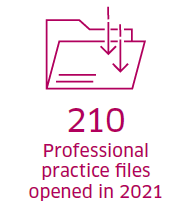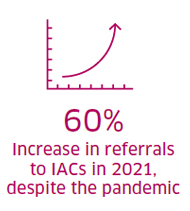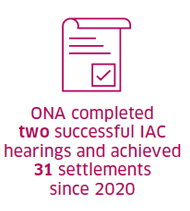The challenges that we have all faced on the front lines of health care often seem insurmountable. But ONA has demonstrated our deep commitment to supporting members through actions, advocacy and perseverance at COVID-19 scientific and government tables.
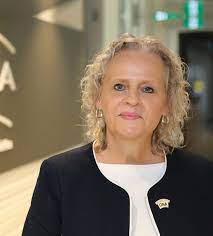
Our achievements reflect ONA’s core function of championing high-quality health care for patients, residents and clients. Since our last Biennial, and despite the global pandemic, ONA has made significant inroads.
Early in 2020, ONA put our full attention on infection prevention, containment and ensuring members were protected from COVID-19. During a marathon session, we negotiated an agreement with the provincial government for new measures on personal protective equipment, including N95s. ONA spoke out at government tables to protect the health and safety of nurses and health-care professionals. This significant win would not have been possible without thousands of front-line members speaking out and telling us your real work-life stories.
As respected professionals, nurses and health-care professionals have the power to influence health-care change for patients, residents and clients. ONA engages members through town halls, digital storytelling, provincial campaigns, virtual rallies, phone and email zaps and other digital events.
Together, we are a strong, professional labour union that challenges the status quo. Many members, working with support from ONA, are now engaged in rallying, lobbying government and informing Ontarians. This is true member activism spreading across our province.
It is important to look to the future and envision opportunities. ONA’s strategic planning initiative was a major undertaking, beginning in 2020 with member engagement initiatives, including surveys, focus groups and tailored discussions. Throughout the process, members spoke passionately about how you see ONA as a supportive and active union in the years to come. This plan will help shape and set our priorities and our work for members, and will be strategically rolled out over the coming months.
I have heard your horrific stories of working on the front lines. You are stressed, exhausted and angry. The disrespect the Ford government has shown us by passing regressive bills, including 124, 175 and 195, is unfathomable. I share your anger and outrage, and ONA will continue our strong advocacy work to address these bills. We launched a Charter challenge over Bill 124 and will not give up this fight.
The actions of this government have directly and negatively impacted our work in health care. Our collective anger — and collective actions — must be firmly directed where it belongs: at the Ford government. Ontario elects a new provincial government on June 2, 2022, and we will remind all politicians that nurses and health-care professionals vote!
It has been my honour to serve our more than 68,000 RNs and health-care professionals and more than 18,000 nursing students. I remain inspired by the care and compassion of members who work short-staffed, are overworked and exposed. It should not be this way. I am confident in ONA’s future, with strong new President Cathryn Hoy and First Vice-President Angela Preocanin. They, along with the entire ONA Board and dedicated staff, will lead ONA as we continue to advocate for members, for a renewed vision for health care, and to do whatever it takes to improve health care for all Ontarians.
ONA is your union. It is your future.

Vicki McKenna, RN
President, Ontario Nurses’ Association

Cathryn Hoy, RN
First Vice-President
Portfolio: Local Political Action and Professional Issues
I am in awe of the firm action you have taken on your serious workload concerns and harmful government policies over the past two years — very often with positive results! There will be challenges ahead, of course, but by coming together as one strong union, we will continue to triumph. I am excited to continue this important advocacy work with you as ONA President.

Dawn Armstrong, RN
Region 1 Vice-President
Portfolio: Human Rights and Equity
ONA has a diverse membership, and knew the time was now to issue an even stronger statement that we will not tolerate any form of discrimination, harassment, racism or oppression. Our new member Anti-Racism Advisory Team will provide guidance, including how we can do better as an organization. We have a lot of work ahead, and need you all to play a part.

Bernadette Robinson, RN
Region 2 Vice-President
Portfolio: Education
If there’s one thing we learned from the pandemic, it’s how well we — all of us together — can adapt to change. While faceto- face meetings are always preferable, we eagerly embraced other options, including digital learning, with tremendous success. We will continue to use those platforms, particularly helpful for our northern and rural members, as needed.

DJ Sanderson, RN
Region 3 Vice-President
Portfolio: Labour Relations
Labour relations, such as contract negotiations and grievance handling, is the primary function of our union, the core services you expect from us. While COVID-19 certainly presented additional challenges, we never lost sight of that, and effectively met members’ increased needs using any and all means possible — and will continue to do so.

Angela Preocanin, RN
Region 4 Vice-President
Portfolio: Occupational Health and Safety
If ever there was a time that showed us how vital robust health and safety policies are, both provincially and within our workplaces, it was the past two years. You successfully took up the fight for personal protective equipment and other needed precautions, knowing that if you aren’t safe, neither are those under your care. Together, we must never stop pushing for that. I promise that as your new First Vice-President, I will always have your back.

Karen Bertrand, RN
Region 5 Vice-President
Portfolio: Local Finance
Local executives have stepped up to the plate by adopting strategic planning that allowed them to proactively respond to the changes the pandemic brought to the priorities in their budgets. Through this planning, they demonstrated leadership well done for your union, for your future! I look forward to seeing this work continue after my retirement in December, and thank you all for everything you do.
At our last Biennial Convention in 2019, could any of us imagine how our lives were about to be thrust upside down? It’s hard to even begin to describe the demands placed on all of us — most especially our incredible front-line RNs and health-care professionals.
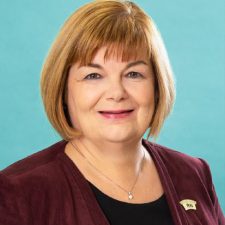
While you were already facing unprecedented challenges related to a provincial government that questioned the value of public health and community care, valued dollars and restrained spending above quality health care, and targeted — again — our female-dominated professionals in regressive policies, the COVID-19 pandemic managed to put even those challenges in perspective.
Despite this, I believe that ONA — your union — has risen to the challenge of continuing to provide the best service to our members of any health-care union in Canada.
Every ONA staff person — from our Labour Relations Officers (LROs), legal staff to our service team members — has demonstrated their dedication and flexibility to ensure you still have access to representation and services when you need it. They have all come together, many “behind the scenes,” as part of the greater Team ONA.
Despite public health guidance that shut down our offices, we quickly found new ways to work. In a pandemic that meant no face-to-face meetings, we adopted technology to continue to provide uninterrupted service to you.
That technology includes the way we are meeting for our 2021 Biennial Convention. It also means that ONA has been able to come up with creative solutions to handle labour relations (negotiating via Zoom), legal matters (arbitrations and court hearings via Zoom), finance challenges (dual dues refunds), and, well, almost every aspect of our work to serve you.
I want to thank our staff, the Board of Directors, and most of all you. While the Ford government continues to do its best to undervalue and disrespect our professions, please rest assured that ONA is doing everything in our power to reverse the outrageous actions and policies they have put in place.
The day of reckoning for this government will come. In the meantime, your LROs have done their very best to represent you, our legal team is pursuing every avenue to undo the regressive legislation and policies that have hurt members, and we will not stop fighting on your behalf.
Make no mistake — this government has targeted RNs and health-care professionals since it came to power through legislation that interferes with collective bargaining and overrides collective agreements. That time in power will end next June. While the Premier would like nothing better than to divide and conquer ONA members, in the end we will emerge stronger than ever.
Part of that strength is our determination. As a team, ONA leaders, the Board, staff and management will not give up until this government’s policies are a distant memory.
Thank you again for all you do, and thank you again to our staff who make me so proud every day.

Beverly Mathers, RN
Chief Executive Officer, Ontario Nurses’ Association
 Campaigns: To get our message out on key issues, ONA embarked on advertising campaigns every month throughout 2020-21, utilizing TV, radio, print and social media ads. This included our month-long Ontario-wide “Holding the Line” campaign, featuring members’ resilience during the pandemic; and our “Keep Nursing Strong” campaign on the impact of COVID-19. View ads at https://nursesknow.ona.org and https://www.keepnursingstrong.ca.
Campaigns: To get our message out on key issues, ONA embarked on advertising campaigns every month throughout 2020-21, utilizing TV, radio, print and social media ads. This included our month-long Ontario-wide “Holding the Line” campaign, featuring members’ resilience during the pandemic; and our “Keep Nursing Strong” campaign on the impact of COVID-19. View ads at https://nursesknow.ona.org and https://www.keepnursingstrong.ca.
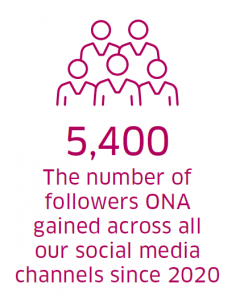 Social Media/Website: ONA made significant strides in digital communications, amplifying our voice on social media and using Instagram more to broaden our audience. We made our website more user-friendly, adding additional interactive pages. Supported by staff, more Locals are building their own websites.
Social Media/Website: ONA made significant strides in digital communications, amplifying our voice on social media and using Instagram more to broaden our audience. We made our website more user-friendly, adding additional interactive pages. Supported by staff, more Locals are building their own websites.
Media: Public health and RN cuts, the pandemic, pay equity and two long-term care (LTC) commission reports were just part of ONA’s media focus. From January 2020 to August 2021, ONA held several news conferences, issued 128 media releases, completed 816 media interviews, and wrote 20 letters to the editor and 11 opinion editorials. We also met with the Toronto Star’s editorial board to provide information on LTC and worked with that paper on a front-page exclusive on pandemic outbreaks in LTC homes.
Nursing Week: While the pandemic meant members had to celebrate Nursing Week differently, many Bargaining Units planned virtual and safe socially distanced in-person events. Members submitted their stories, which filled our social media pages and were featured in Front Lines.
Government Relations
With our continued pressure yielding results, ONA forced the Ford government to include social workers as care coordinators in the next transition to the newly restructured Ontario Health Teams that will include home and community care. In the initial proposal, only regulated health professionals under the Regulated Health Professions Act would be able to practice as care coordinators.
ONA also supported the movement for paid sick days in Ontario. Relentless public pressure forced the government to introduce a temporary COVID-19 paid sick leave program for workers, but the struggle continues for permanent paid sick leave.
Fighting for fairness was also a common theme of ONA’s work with our nursing student affiliates. Nursing students were part of a legal challenge of the Ford government’s “Student Choice Initiative,” supported by ONA, which mandated universities/colleges to allow students to opt out of some ancillary fees, devastating student organizing. In November 2019, Ontario’s Divisional Court struck down the policy, and in August 2021, the government’s appeal was dismissed. With ONA’s assistance, nursing students also called on the government to fix their clinical placements, which were cancelled due to the pandemic. In May 2021, the government announced funding to expand clinical education placements and introduced a clinical extern program.
Member Mobilizing
With a new member mobilizer and strategy launched, ONA saw thousands of nurses and health-care professionals organize together to make workplace and political change.
Of note were three virtual days of action where hundreds of emails and phone calls were made to Premier Ford and his cabinet to demand personal protective equipment, full-time RN positions and the phasing out of for-profit LTC; in our first-ever phone zap, members flooded the telephone lines of cabinet ministers to demand the repeal of wage-suppressing Bill 124; and in a virtual rally of more than 700 nurses, health-care professionals and community allies, we demanded respect and fair wages.
We had much success in our Bargaining Units too. For example, the pediatric and special care nurses at Guelph General Hospital flooded their CEO and Board of Directors with letters and a petition demanding they stop the merger of their two units, which would put the safety of babies and children in their community at risk. As a result of this action, cross-training is now voluntary and additional staffing must be implemented.
Reiterating the shortcomings in LTC we have brought to government tables since long before the pandemic hit, adding powerful new statistics and information, highlighting the heartbreaking personal accounts of our brave LTC members, gleaned from hundreds of interviews and surveys ONA staff conducted, and compiling meaningful recommendations to ensure a tragedy like this never happens again, ONA prepared three reports for the Commission: COVID-19 in Long-Term Care: ONA Survey Results; ONA’s Final Submissions and Recommendations; and Are We in This Together? The Voices of Ontario’s Long-Term Care Nurses.
We also commissioned a fourth report, Fatal Choices: COVID-19, Nursing and the Tragedy of Long-Term Care, authored by Mario Possamai, former senior advisor to the Ontario SARS Commission, which thoughtfully analyzes the circumstances and decisions made in LTC that led to its current state.
It was a mammoth task, taking place over many months, but our members’ horrific tales about a lack of personal protective equipment (PPE), employers refusing to cohort residents, severe staff shortages and so much illness and death — to name but a few — were clearly heard. After two interim reports, the Commission released its final 322-page report on April 30, 2021, containing 85 recommendations that address the long-standing neglect of LTC (see box). The report anonymously quotes many ONA members, and its recommendations echo many of ours.
The report recommends that LTC homes adopt a person-centred model of
care, which focuses on treatment and resources based on residents’ needs,
and that the role of for-profit operators be reduced to accessing capital and
building new homes, not running them. It also emphasizes the importance
of the precautionary principle and called for immediate changes to increase
staffing and align wages and benefits with those in public hospitals. They
further called for increased government funding, an effective inspection
regime, and strengthened whistleblower protection, along with a number of
recommendations on pandemic planning and the maintenance of a PPE stockpile.
The Commission made it clear that the time for action is now. There will
be future pandemics and Ontario must be ready. ONA will relentlessly push
to ensure these recommendations are implemented so the tragic deaths of so
many were not in vain.
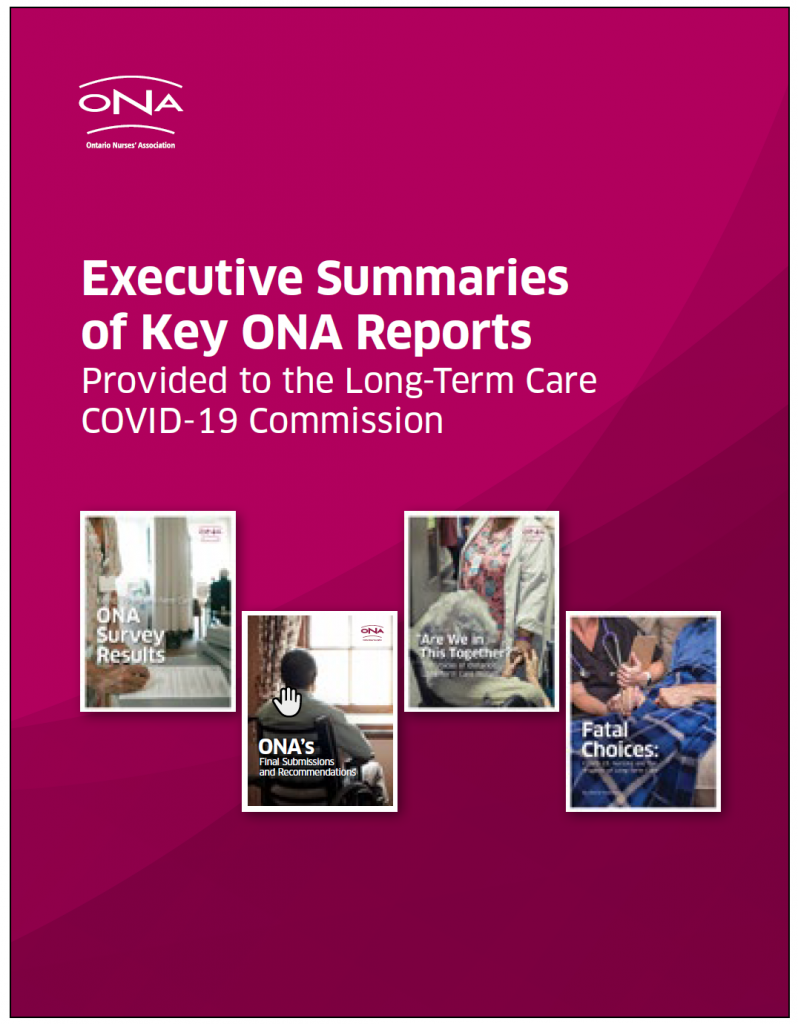


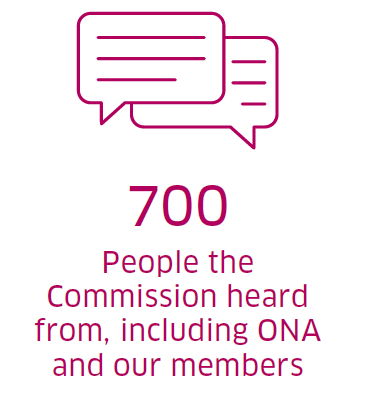
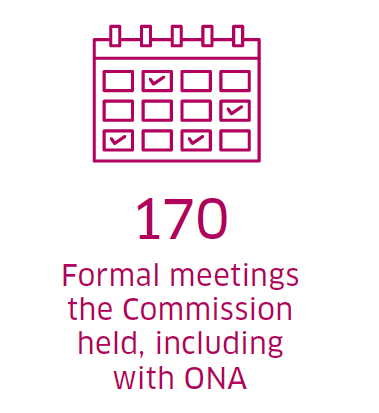
It also meant that our normal representation to members was done virtually, as labour arbitration and adjudication moved online. Our caseload didn’t let up, but we continued to provide a high level of service. Here are some highlights.
Injunction
In April 2020, faced with Ministry of Labour, Training and Skills Development (MLTSD) inspectors unwilling to issue orders, no help from local Medical Officers of Health, and knowing that expedited arbitration was too slow to get the urgent health and safety issues of members addressed, ONA took the extraordinary step of filing a motion for an injunction in the Ontario Superior Court, seeking immediate compliance with the government’s Directives #3 and #5.
The motion was heard by Justice Morgan on April 22 and granted the following day. His decision, which relied heavily on the precautionary principle and quoted Justice Campbell from the SARS Commission Report, states:
One need only read the affidavits of the individual nurses in this Application record to understand that they spend their working days, in particular during the current emergency situation, sacrificing their personal interests to those of the people under their care. And given the nature of the pandemic, they do this not only for the immediate benefit of their patients but for the benefit of society at large. To suggest that their quest for the masks, protective gear, and cohorting that they view as crucial to the lives and health of themselves and their patients represents a narrow, private interest seems to sorely miss the mark.
Long-Term Care: Stout Award
Following the injunction, ONA negotiated an expedited hearing date for an arbitration involving all participating homes. Arbitrator John Stout met with the parties on May 4, 2020, resulting in an award that ordered homes to implement a wide range of infection control and health and safety measures, including engineering, administrative and personal protective equipment controls, such as access to N95 respirators based on the nurse’s point of care risk assessment (PCRA).
Occupational Health and Safety (OHSA) Appeals
We filed an unprecedented number of OHSA appeals in the past two years: 23 in 2020, with 10 in the first two months of the pandemic alone. The appeals covered many sectors: 18 hospital, one Local Health Integration Network (LHIN), two long-term care and two home care.
ONA secured settlements in most of these appeals, including where employers agreed to respect the PCRA, and with the MLTSD, which agreed their inspectors would be directed to interpret Directive #5 consistent with the integration of Justice Morgan in our injunction (see previous column). Other cases proceeded to hearing, and litigation is ongoing.
Important Arbitration Awards
Highlights from non-pandemic awards include:
- Grand River Hospital: Nurses to be compensated for time spent recertifying for Advanced Cardiovascular Life Support as a learning opportunity under Article 9.07 of the Hospital Central Agreement.
- Corporation of City of Windsor Huron Lodge: Percentage in lieu for parttime nurses applies to overtime hours.
Number of Litigation Cases
4,729
Cases at arbitration
2,233
Cases resolved
October 1, 2019 to August 31, 2021
In March, the Ontario Court of Appeal ruled that a 2016 Pay Equity Hearings Tribunal decision regarding pay equity maintenance for women working in participating nursing homes is unreasonable. It held that the fundamental purpose of the Pay Equity Act is to redress systemic discrimination in compensation, and to do so, there must be an ongoing comparison between male and female job classes.
While the COVID-19 pandemic has disproportionately impacted the dedicated nurses and health-care workers in these homes, the majority of whom are female, and the Ford government has praised them publicly, it hasn’t backed that up with the respect that equal pay — a fundamental human right protected by the Act, as well as numerous international human rights laws that Canada has ratified — would provide.
The long legal challenge pitted ONA and the Service Employees International Union (SEIU) Healthcare against the participating nursing homes and government. At issue was how, under the Act, a female-dominated workforce should determine their pay is equitable with men when they have few male coworkers.
This is a significant win, not only for our members at these for-profit nursing homes, but for all working women in Ontario.
—ONA President Vicki McKenna, RN
In such situations, the Act provides a proxy method, allowing a female-dominated workplace to be compared with a female job class from a similar workplace that has already been compared with a male job class and achieved pay equity. ONA and SEIU argued the proxy method must be continually repeated to maintain pay equity, while the participating nursing homes and government believed it should only be used to establish it.

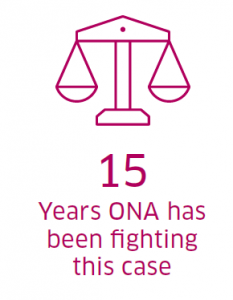 In 2016, we brought the matter before the Pay Equity Hearings Tribunal, which rejected our stance, instead providing a formula for pay equity maintenance that did not include the proxy method. However, the Divisional Court ruled that decision unreasonable, finding the Act required an ongoing comparison with male workers, and sending the case back to the Tribunal to determine how that could be achieved. The participating nursing homes and government appealed.
In 2016, we brought the matter before the Pay Equity Hearings Tribunal, which rejected our stance, instead providing a formula for pay equity maintenance that did not include the proxy method. However, the Divisional Court ruled that decision unreasonable, finding the Act required an ongoing comparison with male workers, and sending the case back to the Tribunal to determine how that could be achieved. The participating nursing homes and government appealed.
The Court of Appeal ruled the Tribunal’s decision unreasonable and that the Act made it clear “ongoing access to male comparators through the proxy method is required to maintain pay equity.” This decision is a huge victory for our members and all working women in Ontario!
While the Ford government and the homes filed an appeal with the Supreme Court of Canada (SCC) — during Nursing Week, no less! — we prevailed there too! In October 2021, the SCC dismissed their application for appeal, meaning the Ontario Court of Appeal’s decision stands and this unnecessary and discriminatory battle to prevent the gender wage gap from widening is over.
Probationary Nurse Reinstated
A probationary nurse was unable to attend orientation within the designated timeframe scheduled by the employer and terminated. Although probationary terminations are sometimes challenging to overturn, ONA filed a grievance on behalf of this nurse and argued in favour of reinstatement. Because this nurse had previously worked as an RPN on the same unit before transferring into the RN role, we argued that a full orientation was not required, making the employer’s decision to terminate on those grounds unreasonable.
ONA asserted that there were several factors beyond the nurse’s control that led to an inability to attend the orientation in the timeframe specified, including a COVID-19 outbreak, which required the nurse to self-isolate as per Ministry of Health and public health directives. We emphasized that our member was not intentionally truant and the decision to terminate was an unreasonable enforcement of management powers relating to probationary nurse releases in the collective agreement, and should be overturned. The employer accepted ONA’s arguments and facts, and agreed to reinstate the member.
Retroactive/LTD Payments Achieved
A member had depression that was intensified by their work environment, and resulted in workplace attendance issues. They received counselling and specialized medical treatment. Their disability required times of rest, treatment and medication changes, and they were able to reintegrate back to work successfully. Unfortunately, the nurse’s illness became profound, and they could not recover and return to work. Combined with the member’s occupational health file and medical reports — and after filing a grievance and completing a long-term disability (LTD) appeal — ONA was successful in achieving retroactive payments dating back to December 2019, along with monthly LTD payments.
Attendance Support Program Suspended
A hospital in northern Ontario decided to reinstate and put into effect its Attendance Support Program (ASP) policy during the pandemic. ONA members felt frustrated and unsupported by the employer, fearing they could be penalized for absences due to the potential of increased absenteeism from working in a COVID-19 environment and possibly having to self-isolate in accordance with public health guidelines and the directive to not attend the workplace if experiencing COVID-19 symptoms. ONA filed an association grievance, noting that reimplementing the ASP during a global pandemic is an unreasonable rule and exercise of management rights. We were successful in having the employer cease the reinstatement of the ASP policy.
| Grievances | Total |
|---|---|
| Home and Community Care Support Services (Local Health Integration Networks) | 459 |
| Clinics and Industry | 269 |
| Public Health Units | 588 |
| Home Care | 301 |
| Homes for the Aged | 1,436 |
| Nursing Homes | 3,304 |
| Hospitals | 11,544 |
| Total (this includes all COVID-19 related files) | 17,901 |
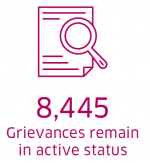
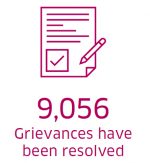
The Ford government’s Bill 124, which caps wage and benefit improvements at a maximum of one per cent per year for each of three years, removes the right to freely bargain in many sectors and, therefore, impacted recent negotiations (held via Zoom).
Despite that, ONA continued to negotiate based on membership priorities — and we achieved several wins in various sectors. Significantly, no central bargaining improvements were removed or rolled back.
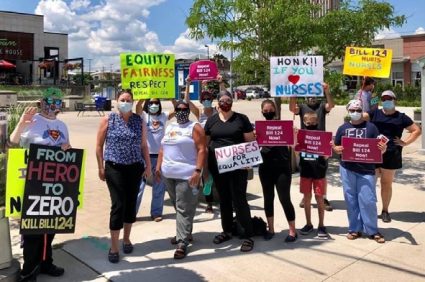
Hospital Central Bargaining: The arbitration decision that affects 60,000 hospital members was released in September 2021. While RNs and health-care professionals received an insulting one per cent wage increase, ONA achieved improved language related to human rights and equity, and health and safety, foundational issues for which we have long advocated.
Not-for-Profit Nursing Homes Central Bargaining: ONA has 15 homes in this group, which received a one per cent increase in each of three years, along with very small increases to shift and weekend premiums, in an arbitrated contract affected by Bill 124. Improved language related to personal protective equipment and pandemic planning was negotiated.
For-Profit Nursing Homes Central Bargaining: For ONA’s 184 nursing homes and approximately 3,000 members, an arbitrator issued a 1.75 per cent increase in each of three years, along with increases to standby and responsibility pay, shift and weekend premiums, some benefit improvements, a vacation gain, and a direction for the parties to negotiate student supervision and mentorship premiums.
Homes for the Aged: Homes for the aged are both non-profit/charitable or municipal. The non-profit are affected by Bill 124. Municipal homes (not affected by Bill 124) achieved wage settlements of up to two per cent; charitable homes received one per cent. In these cases, ONA is proceeding to arbitration to maximize bargaining outcomes while ensuring we have recourse when our Bill 124 Charter challenge is successful.
Home Care Providers: Victorian Order of Nurses members’ new contract runs until 2023. With the precariousness of home care work, especially during COVID-19, ONA achieved a commitment from the employer regarding infectious disease management. The new contract provides much-needed clarity and consolidates some language to make it consistent across Bargaining Units, something that ONA has long demanded. A new letter of understanding regarding the employer’s commitment to equity, diversity and inclusivity is a key win for members.
Public Health: The Ford government had announced its intent to merge the province’s 34 existing public health units into 10 new entities, which was delayed due to COVID-19. Should the government proceed with restructuring, funding will likely be impacted. Over the past two years, several public health units received wage settlements in the range of two per cent with improved benefits.
Community/Industry/Clinics: ONA achieved decent settlements for several Bargaining Units, including Canadian Blood Services (CBS) and the Canadian Mental Health Association. In these instances, the Ford government’s Treasury Board requested a submission from ONA because it stated that achieved agreements are in violation of Bill 124. ONA provided our submissions, including our assertion that CBS does not fall under the legislation. In other circumstances, based on membership direction, there have been settlements for one per cent, which contain re-opener provisions.
Home and Community Care Support Services (formerly known as Local Health Integration Networks): Bill 175, which received Royal Assent on July 8, 2020, transfers home and community care to Ontario Health Teams. Although this transfer stalled due to COVID-19, ONA is beginning to see changes occurring that will impact our members. Most collective agreements do not expire until 2022; ONA will be watching how the changes affect members’ rights to bargain.
ONA is very proud of our unique and indispensable LEAP service, which provides representation/assistance to members who face a complaint/report against them at their regulatory college or have a medical condition impacting their ability to practice.
When the health-care system was hit by COVID-19 in 2020, LEAP cases at the College of Nurses of Ontario (CNO) temporarily slowed down while the CNO adjusted to the impact of the pandemic. However, complaints to the CNO increased again and we found that a growing number of cases arose in circumstances where the pandemic played a role in the allegations.
Of the COVID-19-related complaints and reports we tracked, the most common cases are family complaints about not being able to attend at the death of a loved one due to pandemic restrictions. Complaints have also arisen at COVID-19 testing centres and vaccine clinics regarding communication and care. Finally, there are employer reports regarding a variety of issues, including members failing to follow COVID-19 precautions.
Most of these COVID-19-related cases are still in the early stages with the CNO and awaiting investigation. When the investigations are complete, ONA will write detailed submissions that address the allegations in the full context of the pandemic, including the settings in which our members were working and the significant practice challenges they faced.
Number of LEAP Files Opened Per Year
Regulatory College Outcomes
Working in tandem with our Bargaining Units and front-line members, ONA reached a number of critical wins through the professional responsibility workload process (PRWP), demonstrating how important this tool is in addressing the serious workload concerns of our members.
Here are just two highlights:
Women’s College Hospital, Family Practice Unit
Through the PRWP, binding Minutes of Settlement were achieved in 2021 for the Family Practice Unit (FPU) at Women’s College Hospital (WCH), which restored laid-off RN positions and provided other significant improvements to the workplace culture.
The saga began in 2014, when WCH laid off 50 per cent of their full-time RN complement in the FPU. Acutely aware this would significantly compromise their ability to provide safe, effective, quality, ethical care to their patients, ONA members used all resources available to dispute this change.
The nurses filed a grievance that went to arbitration, along with a complaint with the Ministry of Labour, Training and Skills Development for unfair labour practices. They wrote letters to WCH’s Chief Executive Officer and Board of Directors, and took action to raise public awareness.
Finally, they initiated the professional responsibility clause in their collective agreement, holding their manager, director and chief nursing executive accountable for their decisions and actions by completing multiple workload forms.
St. Mary’s General Hospital, Emergency Department Independent Assessment Committee (IAC)
An IAC hearing took place in June 2021, resulting in 79 recommendations in 11 areas for improvements to the emergency department (ED) at St. Mary’s General Hospital. The key recommendation was for an increase of five RNs in a 24-hour period.
The RNs began reporting workload and practice issues in 2018, submitting 219 workload forms over three years. Issues included inadequate RN staffing, escalating patient volumes and acuity, serious delays to initial triage, scope of practice concerns for RPNs and novice RNs, equipment issues, and insufficient training and mentorship supports, as well as serious concerns with morale, the workplace environment and poor leadership.
The IAC made recommendations regarding admitted patients in the ED, human resource planning and RN staffing, skill-mix issues, education, equipment, workplace violence, leadership and communication. The IAC also addressed workplace violence and safety, identifying ED nurses as the highest risk group for violent patient encounters. Additionally, the panel made several recommendations related to morale and the toxic workplace environment.
This astounding report, if implemented, will lead to a greatly improved practice environment.
“Ask a Specialist” Webinars
To facilitate this work, ONA introduced a new web-based initiative called “Ask A Specialist” in November 2020. This program, which includes a variety of webinar sessions for front-line ONA leaders and grassroot members, provides an opportunity for them to learn more about the PRWP by speaking directly to a Professional Practice Specialist. The webinars have proven enormously successful, with 70 leader sessions (191 attendees) and 76 member sessions (395 attendees) from November 2020 to August 2021.
Nurse Practitioner (NP) Focus Group
In 2020, ONA established an NP Focus Group, comprised of one NP representative from each region, to provide a forum for these members to voice and advance their interests, professional considerations, and recommendations for collective bargaining. The representatives obtain feedback from NPs in their respective regions and report back to them on any recommendations made by the focus group. The focus group has already achieved many objectives, including collaborating on a government submission on the use of physician assistants, creating a podcast that spotlights NPs in their work environment, and providing information on the benefits of ONA membership at our virtual booth at the 2021 Nurse Practitioners’ Association of Ontario’s conference.
ONA proudly supports human rights and equity (HRE), as detailed in the Canadian Charter of Rights and Freedoms and the Ontario Human Rights Code.
We continue to build and improve our understanding and work towards equality for members, and eliminate racism, discrimination and harassment in workplaces and society.
Anti-Racism/Anti-Oppression Work
In 2020, ONA developed a position statement on anti-racism for Locals, Bargaining Units and members to access and disseminate. The statement provides overarching themes and underscores the need to listen, understand and educate.
ONA continues to take corrective steps — both in the shorter and longer term — to address and act against all forms of racism. Our new Anti-Racism Advisory Team, comprised of racialized front-line members, has begun its vital work to develop fulsome strategies to promote inclusion and acceptance with a human rights and equity lens. ONA is proud to be one of the first nurses’ unions in Canada to address this issue with a dedicated team.
Our work is far from over as we continue to promote and support human rights and equity through extensive pressure at the bargaining table, and lobby for positive changes in legislation, including the discriminatory Bill 124.
Human Rights and Equity Team
ONA’s strong Human Rights and Equity Team has no shortage of work in supporting members’ workplace HRE issues. The team has taken a more holistic approach in addressing the issues members face daily. Team members have been instrumental in providing new and innovative ways to engage our membership throughout the year. One HRE team member eloquently notes, “human rights and equity should not just be thought of as patchwork; it needs to be woven into our daily lives.”
The team’s approach — and its diligence in addressing issues — is a testament to perseverance and dedication.
Outreach Initiatives
Part of ONA’s work in advancing HRE is education. Over the past two years, we have developed several member-driven initiatives:
- HRE Book Club: Dozens of members and staff have joined the book club to discuss HRE-themed books and memoirs. In this safe environment, conversations have been respectful, thoughtful and a welcome break for attendees.
- Anti-Black Racism: In 2020, ONA introduced several initiatives regarding anti-Black racism. A digital offering — available on ONA’s YouTube channel (http://www.youtube.com/OntarioNurses) — by a number of our members spearheaded this initiative. The 2020 HRE Caucus theme, which will continue for the 2021 Caucus, also built on this, with in-depth discussions and reflection on confronting racial discrimination through solidarity.
- Commemorative Dates: ONA continues to research, plan and promote special days within the calendar that focuses on human rights. These include Black History Month, International Women’s Day, National Indigenous Peoples Day and Pride.
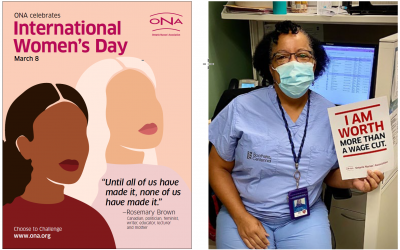
“Human rights and equity should not just be thought of as patchwork; it needs to be woven into our daily lives.”
—HRE Team member
Health and Safety
ONA works relentlessly to safeguard members from occupational health and safety (OHS) hazards, including COVID-19.
Our OHS Specialists provide steadfast support to members and staff. Over the past two years, this included assisting with several key initiatives, such as ONA’s response to the Long-Term Care COVID-19 Commission (see page 6), answering Bargaining Unit questions, responding to outbreaks, supporting complaints made to the Ministry of Labour, Training and Skills Development and participating in appeals.
ONA’s 2021 Health and Safety Caucus taught more than 400 members how to leverage the powers of the Joint Health and Safety Committee (JHSC), including resolving issues through the internal responsibility system, preparing for Ministry visits and providing information needed for appeals. This was one of ONA’s best-attended sessions, with 95 per cent of participants saying it was an effective education day!
New Tools/Resources
On the Safe Side: ONA launched a tailored eBulletin to raise awareness and encourage knowledge exchange about current OHS issues facing members. Brief and timely, it refers readers to supporting information on the ONA website. More than 2,600 have subscribed.
Guide to Fatality, Critical Injury, Illness, Accident and Exposure: This revised guide outlines the purpose of an investigation, employer duties, the powers of the JHSC, and considerations in conducting investigations. Supporting documents are on our website.
Gathering the Facts: Given the appeal deadline of 30 days from the Ministry’s field visit, ONA found we were still in the fact-finding phase close to the appeal deadline. So we created a rigorous fact-finding document, instrumental in focusing on information needed to enforce members’ rights. This provides ONA with a greater ability to respond efficiently.
Ministry Orders: A new webpage is dedicated to notable Ministry orders (www.ona.org/orders). It highlights noteworthy orders issued and their significance, including those that result in resolved safety issues and/or support the JHSC and workers’ rights. This page will grow as orders are received.
Two New Toolkits: OHS Specialists supported the Public Services Health and
Safety Association’s development of two Violence, Aggression & Responsive
Behaviour (VARB) Toolkits:
- Emergency Response to Workplace Violence.
- Work Refusal and Workplace Violence Toolkit.
Toolkits can be found at https://workplace-violence.ca.
Workplace Safety and Insurance Board (WSIB)
Occupational Health Clinics for Ontario Workers (OHCOW)
Collaboration ONA partnered with OHCOW on WSIB COVID-19 denials. OHCOW’s expertise provides opinions on causation and cases where members have ongoing issues, which enables ONA to obtain timely medical opinions and supports and ensure the WSIB is consistent in dealing with cases. ONA is the first union to collaborate with OHCOW.
Chronic Mental Stress Appeals Win
Following an ONA groundbreaking 2015 Charter challenge on prior exclusion in WSIB legislation of claims for chronic mental stress (CMS), current WSIB legislation and policy allow entitlement for CMS claims in certain circumstances (just six per cent of CMS claims have been allowed by WSIB over a three-year span). ONA won three CMS appeals that affirm recognition that discriminatory, harassing and abusive behaviour can lead to psychological injury and are not part of a normal working environment.
| Item | Total |
|---|---|
| Written and oral submissions | 189 |
| Files closed | 138 |
| Initial merit reviews | 409 |
| Workplace Safety and Insurance Appeals Tribunal wins | 90% win rate |
| Appeal wins | 77% win rate |
| Money in members’ pockets | $1,002,067.63 |
The COVID-19 pandemic provided different challenges and unique opportunities for ONA’s organizing efforts.
Following government directives, the Ontario Labour Relations Board suspended in-person votes, and all applications had to be filed electronically.
In view of these directives, and to help reduce the spread of COVID-19 and its resulting impact on nurses and health-care professionals, the public and staff, ONA also prohibited in-person meetings with potential groups. This meant a change in the systems and practices that have always been a mainstay of our organizing efforts.
Instead of in-person meetings, our organizers developed an e-card that was sent to all potential members, which provides a link to information they needed to make an informed choice. This made it easier for them to sign a card. As well, with the new virtual voting system, potential members could cast a secure and confidential ballot.
As an interim solution, we adopted Zoom as the main method of meeting with groups, giving us an opportunity to talk to them “face-to-face” and in live time. With this technology, we were able to answer all of their questions about the benefits of joining ONA.
A leading trend in organizing has been a been a change in the reason nurses and health-care professionals reach out to us. Historically, issues such wages, workplace harassment and transparency have been their main motivations for wanting to join ONA. However, since the pandemic, the concerns relate primarily to health and safety, and workload. The pandemic highlighted to them how vulnerable they are without a union to advocate on their behalf.
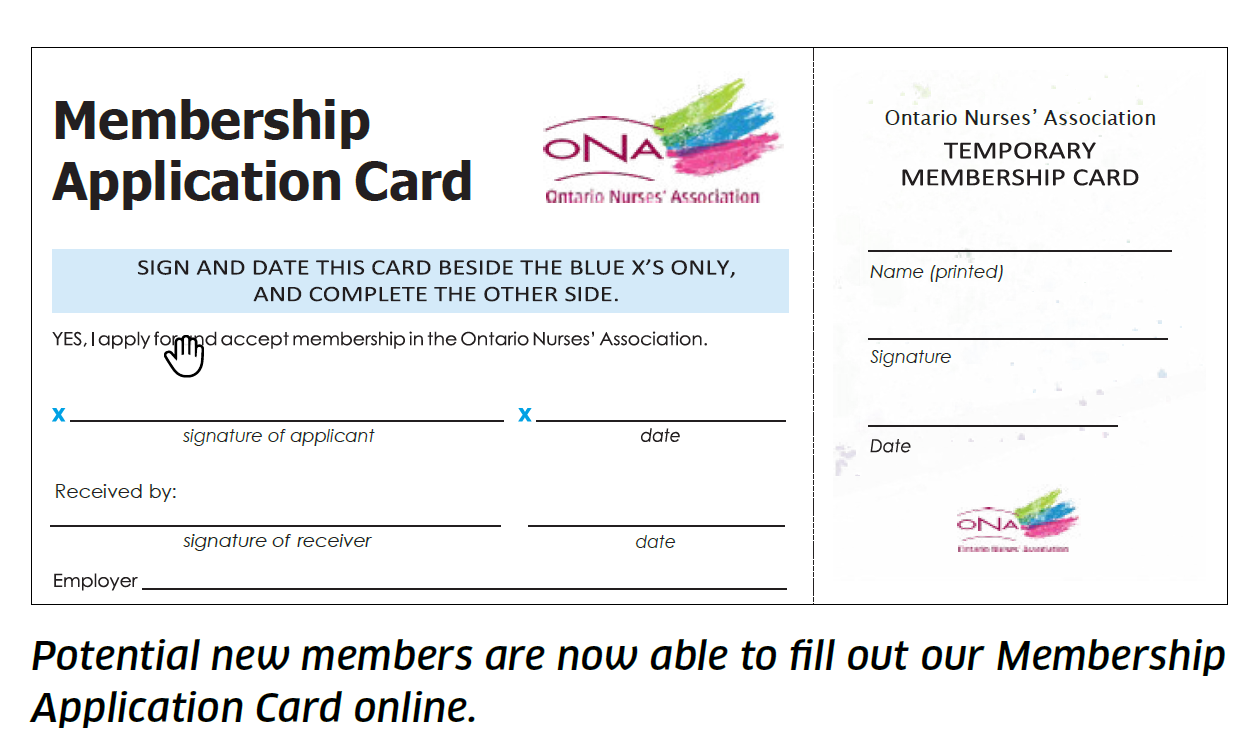
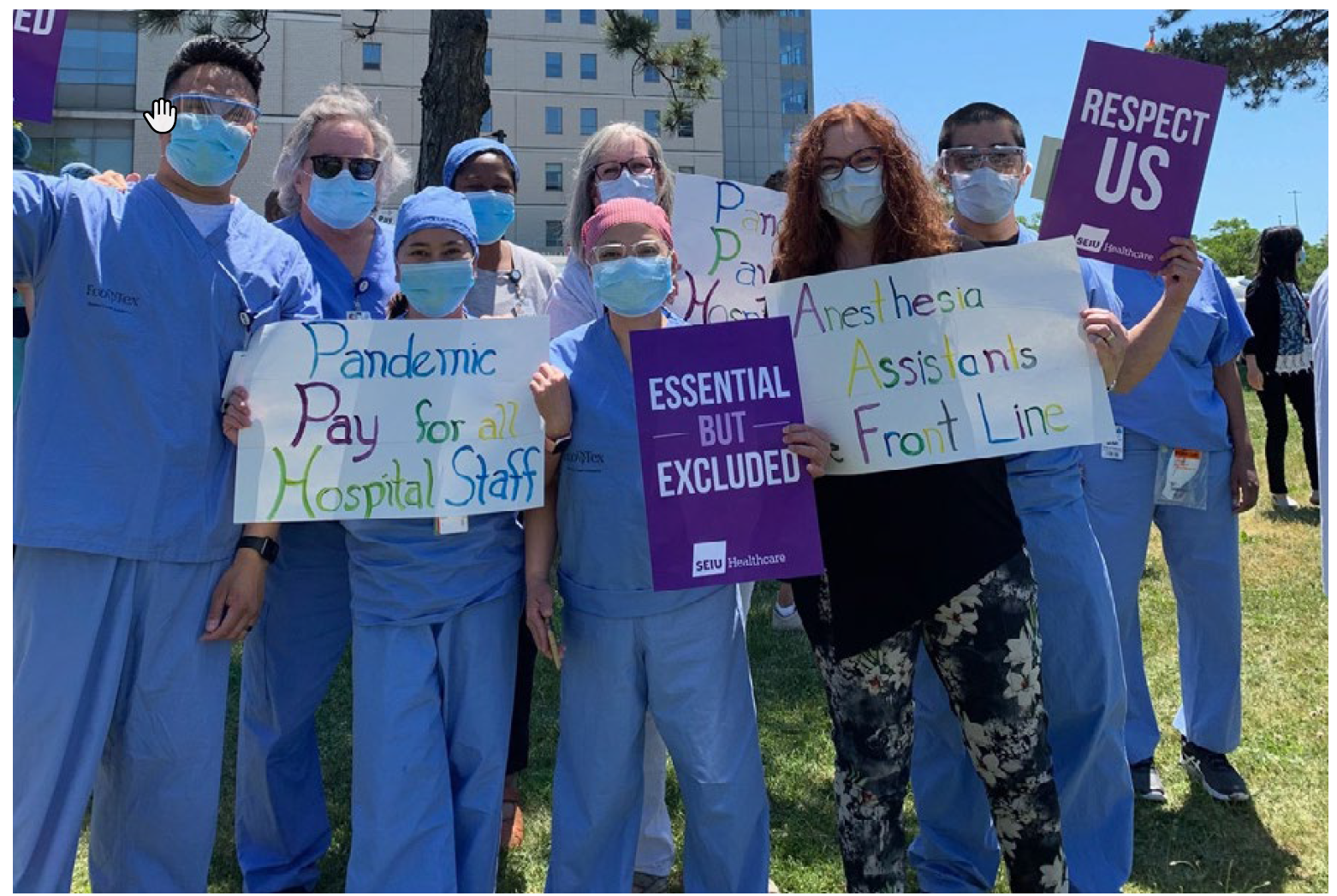
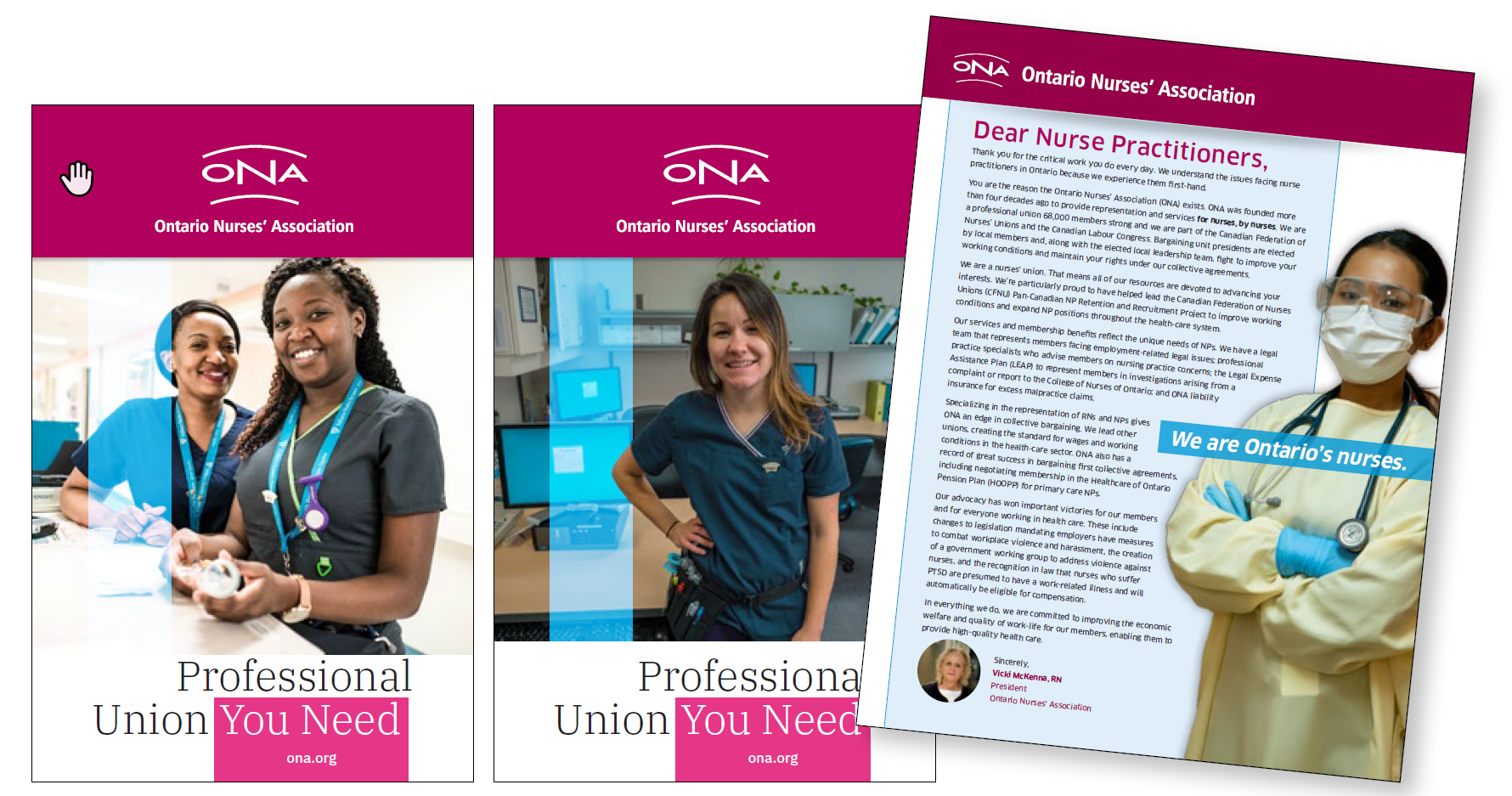
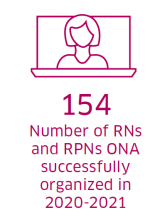
While the past 20 months have been challenging for ONA education to say the least, with a shift from in-person workshops to digital delivery, we rose to the challenge!
This pivot required us to review and edit critical curriculum components and delivery tactics to engage attendees in a totally new environment. Our digital workshops were and continue to be available provincewide for any member with entitlements to attend, regardless of region.
In 2020, many of our in-person education sessions and events were canceled, while others were postponed from the beginning of the year to the fall. The Health and Safety Caucus, for example, normally held each May, took place that October instead, with 462 members and leaders attending. The November 2020 Provincial Coordinators Meeting was held digitally, with ONA President Vicki McKenna’s address, livestreamed via Facebook, reaching almost 41,000 viewers!
We continued in much the same vein in 2021, navigating and adapting to the ever-changing pandemic environment. Our education offerings grew beyond our original three lecturettes to include core workshops reframed for the digital space and on a variety of topic areas.
The following digital events took place in 2021:
- Treasurers/New Local Coordinators Conference — January 26-28.
- Special Meeting — February 16.
- Provincial Leadership Meeting — March 30-31.
- Health and Safety Caucus — Throughout the month of May (separate dates via region).
- June Provincial Coordinators Meeting — June 15-16.
- Leadership Accountabilities Forum — September 23-24.
The health and safety of our participants and staff are our priority. We continually review our practices to ensure the wellbeing of all participants and partners, following public health guidelines and government restrictions. ONA members have embraced the digital experience! They can now participate in ONA education from their own space, without the added stresses of travel.
When environmental conditions allow a safe return to in-person learning, ONA’s education program will continue using digital tools to remove barriers and ensure that all members can access education opportunities wherever they are.

Workshop Attendees (Total: 1, 039). January 1 to July 31, 2021
Thank you for reading the 2021 Biennial Report
“This has been a tremendously challenging time for nurses and health-care professionals. But it has also been a time when members have come together like never before to fight for your rights, your health and safety, and the care you are able to provide your patients, residents and clients. And that solidarity, that tenacity will serve us well in the years to come because when we rise together as one strong union, we soar.” —ONA President Vicki McKenna, RN


